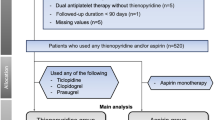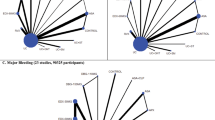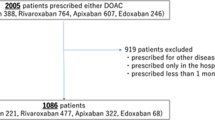Abstract
Chronic warfarin anticoagulation is commonly used to prevent thromboembolism in patients with atrial fibrillation or venous thromboembolism, and in the management of patients with mechanical heart valves. Interruption of long-term anticoagulation therapy for elective, planned urologic procedures in these patients creates a complex situation in which competing risks of thrombosis and hemorrhage must be managed; when anticoagulation is withheld patients are at risk of thrombosis, and when it is restarted they are at risk of hemorrhage. Patients at a high risk of thrombosis are typically given bridging therapy with heparin to reduce the amount of time without anticoagulation. Outcomes from bridging therapy are influenced by patient characteristics, including the risk of thromboembolism from underlying medical conditions and the risk of perioperative bleeding, and by characteristics of the procedures themselves. The safety and efficacy of different approaches are not well documented. Data regarding periprocedural anticoagulation management of urology patients is limited and principally describes outcomes related to transurethral prostate surgery. Results from these studies indicate that various strategies of anticoagulation interruption and bridging therapy result in low frequencies of thromboembolism, but variable rates of hemorrhage. Patients on anticoagulation therapy who are due to undergo invasive urologic procedures that have a low risk of developing thromboembolism can discontinue warfarin 4–5 days before the procedure, and resume it postprocedure. Bridging therapy to prevent thrombosis is necessary for patients at a higher risk of developing thromboembolism. Future research should develop strategies to maintain low rates of thrombosis but reduce the frequency of postoperative hemorrhage.
This is a preview of subscription content, access via your institution
Access options
Subscribe to this journal
Receive 12 print issues and online access
$209.00 per year
only $17.42 per issue
Buy this article
- Purchase on Springer Link
- Instant access to full article PDF
Prices may be subject to local taxes which are calculated during checkout
Similar content being viewed by others
References
Ansell J et al. (2004) The pharmacology and management of the vitamin K antagonists: the Seventh ACCP Conference on Antithrombotic and Thrombolytic Therapy. Chest 126 (Suppl): S204–S233
Douketis JD et al. (1999) Physician preferences for perioperative anticoagulation in patients with a mechanical heart valve who are undergoing elective noncardiac surgery. Chest 116: 1240–1246
Eckman MH et al. (1990) Anticoagulation for noncardiac procedures in patients with prosthetic heart valves. Does low risk mean high cost? JAMA 263: 1513–1521
Singer DE et al. (2004) Antithrombotic therapy in atrial fibrillation: the Seventh ACCP Conference on Antithrombotic and Thrombolytic Therapy. Chest 126 (Suppl): S429–S456
Gage BF et al. (2001) Validation of clinical classification schemes for predicting stroke: results from the National Registry of Atrial Fibrillation. JAMA 285: 2864–2870
White RH (2003) The epidemiology of venous thromboembolism. Circulation 107 (Suppl 1): SI4–SI8
Kearon C (2003) Natural history of venous thromboembolism. Circulation 107 (Suppl 1): SI22–SI30
Prandoni P et al. (1996) The long-term clinical course of acute deep venous thrombosis. Ann Intern Med 125: 1–7
Hansson PO et al. (2000) Recurrent venous thromboembolism after deep vein thrombosis: incidence and risk factors. Arch Intern Med 160: 769–774
Cannegieter SC et al. (1994) Thromboembolic and bleeding complications in patients with mechanical heart valve prostheses. Circulation 89: 635–641
Bonow RO et al. (1998) ACC/AHA guidelines for the management of patients with valvular heart disease: a report of the American College of Cardiology/American Heart Association Task Force on Practice Guidelines (Committee on Management of Patients with Valvular Heart Disease). J Am Coll Cardiol 32: 1486–1588
Hautmann RE et al. (1994) Radical retropubic prostatectomy: morbidity and urinary continence in 418 consecutive cases. Urology 43 (Suppl): S47–S51
Catalona WJ et al. (1999) Potency, continence and complication rates in 1,870 consecutive radical retropubic prostatectomies. J Urol 162: 433–438
Andriole GL et al. (1994) Early complications of contemporary anatomical radical retropubic prostatectomy. J Urol 152: 1858–1860
Neal DE (1997) The National Prostatectomy Audit. Br J Urol 79 (Suppl 2): S69–S75
Mebust WK et al. (1989) Transurethral prostatectomy: immediate and postoperative complications. A cooperative study of 13 participating institutions evaluating 3,885 patients. J Urol 141: 243–247
Uchida T et al. (1999) Factors influencing morbidity in patients undergoing transurethral resection of the prostate. Urology 53: 98–105
Wilson JR et al. (2004) The changing practice of transurethral prostatectomy: a comparison of cases performed in 1990 and 2000. Ann R Coll Surg Engl 86: 428–431
Doll HA et al. (1992) Mortality, morbidity and complications following transurethral resection of the prostate for benign prostatic hypertrophy. J Urol 147: 1566–1573
Lepor H et al. (2001) Intraoperative and postoperative complications of radical retropubic prostatectomy in a consecutive series of 1,000 cases. J Urol 166: 1729–1733
Hedican SP and Walsh PC (1994) Postoperative bleeding following radical retropubic prostatectomy. J Urol 152: 1181–1183
Rodriguez LV and Terris MK (1998) Risks and complications of transrectal ultrasound guided prostate needle biopsy: a prospective study and review of the literature. J Urol 160: 2115–2120
Nielsen JD et al. (1997) Post-operative blood loss after transurethral prostatectomy is dependent on in situ fibrinolysis. Br J Urol 80: 889–893
Mulcahy JJ et al. (1975) Transurethral prostatic resection in patients with prosthetic cardiac valves. J Urol 113: 642–643
Tscholl R et al. (1980) Electroresection of the prostate in patients treated with heparin. J Urol 124: 221–222
Parr NJ et al. (1989) Transurethral resection of the prostate and bladder tumour without withdrawal of warfarin therapy. Br J Urol 64: 623–625
Chakravarti A and MacDermott S (1998) Transurethral resection of the prostate in the anticoagulated patient. Br J Urol 81: 520–522
Hirsh J and Raschke R (2004) Heparin and low-molecular-weight heparin: the Seventh ACCP Conference on Antithrombotic and Thrombolytic Therapy. Chest 126 (Suppl): S188–S203
Gould MK et al. (1999) Low-molecular-weight heparins compared with unfractionated heparin for treatment of acute deep venous thrombosis. A cost-effectiveness analysis. Ann Intern Med 130: 789–799
O'Brien B et al. (1999) Economic evaluation of outpatient treatment with low-molecular-weight heparin for proximal vein thrombosis. Arch Intern Med 159: 2298–2304
Warkentin TE et al. (1995) Heparin-induced thrombocytopenia in patients treated with low-molecular-weight heparin or unfractionated heparin. N Engl J Med 332: 1330–1335
Ranze O et al. (2000) The use of low-molecular-weight heparins in heparin-induced thrombocytopenia (HIT): a cohort study [abstract]. Ann Hematol 79 (Suppl 2): Sa198
Dotan ZA et al. (2002) The efficacy and safety of perioperative low molecular weight heparin substitution in patients on chronic oral anticoagulant therapy undergoing transurethral prostatectomy for bladder outlet obstruction. J Urol 168: 610–613
Douketis JD et al. (2004) Low-molecular-weight heparin as bridging anticoagulation during interruption of warfarin: assessment of a standardized periprocedural anticoagulation regimen. Arch Intern Med 164: 1319–1326
Kabalin JN and Gill HS (1993) Urolase laser prostatectomy in patients on warfarin anticoagulation: a safe treatment alternative for bladder outlet obstruction. Urology 42: 738–740
Bolton DM and Costello AJ (1994) Management of benign prostatic hyperplasia by transurethral laser ablation in patients treated with warfarin anticoagulation. J Urol 151: 79–81
Kingston TE et al. (1995) Further evaluation of transurethral laser ablation of the prostate in patients treated with anticoagulant therapy. Aust N Z J Surg 65: 40–43
Keoghane SR and Cranston DW . (1996) Contact laser prostatectomy in anti-coagulated patients: mixed results. Br J Urol 77: 613–614
Mueller EJ (1998) Contact laser vaporization of the prostate in patients on chronic anticoagulant therapy. Tech Urol 4: 156–159
van Melick HH et al. Laser prostatectomy in patients on anticoagulant therapy or with bleeding disorders. J Urol 170: 1851–1855
White RH et al. (2000) A population-based study of the effectiveness of inferior vena cava filter use among patients with venous thromboembolism. Arch Intern Med 160: 2033–2041
Decousus H et al. (1998) A clinical trial of vena caval filters in the prevention of pulmonary embolism in patients with proximal deep-vein thrombosis. N Engl J Med 338: 409–415
Author information
Authors and Affiliations
Corresponding author
Ethics declarations
Competing interests
The author declares no competing financial interests.
Glossary
- INTERNATIONAL NORMALIZED RATIO (INR)
-
A method that standardizes prothrombin times obtained from reagents of different sensitivities, allowing for comparison between different laboratories
- BRIDGING THERAPY
-
The process of substitution of heparin for warfarin before and after invasive procedures
- FACTOR XA
-
A vitamin K-dependent coagulation factor that is part of the enzymatic complex that activates thrombin from prothrombin
Rights and permissions
About this article
Cite this article
Daniels, P. Therapy Insight: management of urology patients taking long-term warfarin anticoagulation therapy. Nat Rev Urol 2, 343–350 (2005). https://doi.org/10.1038/ncpuro0204
Received:
Accepted:
Issue Date:
DOI: https://doi.org/10.1038/ncpuro0204
This article is cited by
-
Thromboprophylaxis and bleeding diathesis in minimally invasive stone surgery
Nature Reviews Urology (2014)
-
Perioperative management of chronic anticoagulation therapy in urological patients: a cross-sectional survey of practice
Irish Journal of Medical Science (2011)



